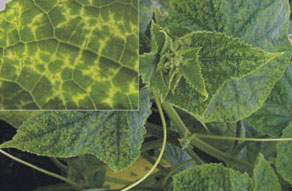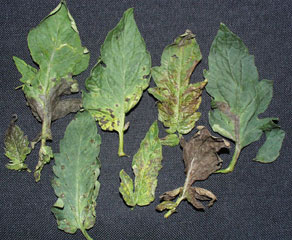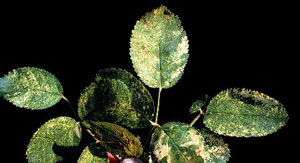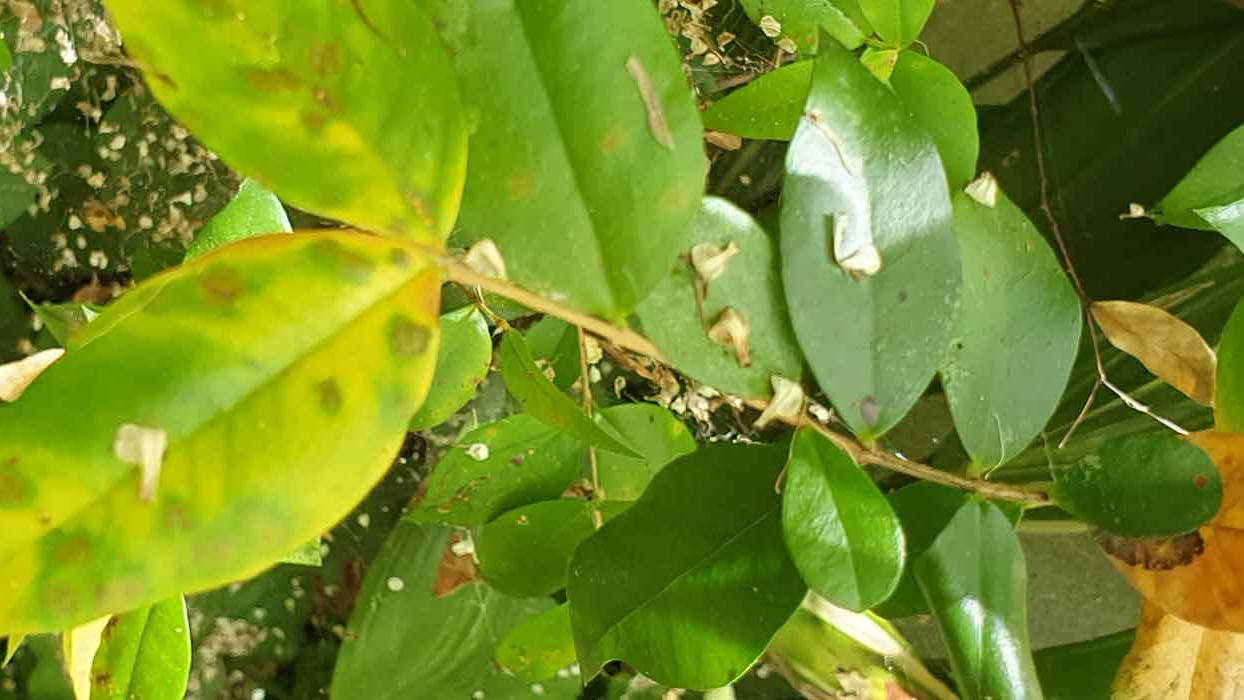A common error gardeners make is to assume that appearance of coloured areas on leaves is caused by natural variegation, fungal infection or nutrient deficiency. In many cases, the variegated colour of leaves of some shrubs, indoor plants, lettuces, herbs is a natural mutation. Happily, this is not a destructive mutation, but one that results in less chlorophyll in some parts of the leaves, causing a paler and mottled effect. Sometimes, keen gardeners have selected these plants and bred from them. These variegated plants can be lower in vigour and shorter-lived than their ‘normal’ relatives but this hasn’t affected their popularity as garden plants.
Variegation Due to Plant Viruses
 There is, however, variegation caused by some sort of plant problem. Although some garden pests, such as aphids can cause leaf yellowing, this colour change is not the only sign of an infestation. A more problematic cause of colour change is infection by disease-causing viruses or virus-like viroids and phytoplasmas, of which there are hundreds. Shown at the left is the leaf symptoms of cucumber mosaic virus (image courtesy of www.whitefly.org).
There is, however, variegation caused by some sort of plant problem. Although some garden pests, such as aphids can cause leaf yellowing, this colour change is not the only sign of an infestation. A more problematic cause of colour change is infection by disease-causing viruses or virus-like viroids and phytoplasmas, of which there are hundreds. Shown at the left is the leaf symptoms of cucumber mosaic virus (image courtesy of www.whitefly.org).
Fortunately, trees and Australian native plants have few virus disease problems and, interestingly, viruses in wild-growing plants don’t seem to develop disease, although they have not been studied as well as cultivated plants. It is in cultivated plants, mainly food crops, that virus infection is of most concern. Because viruses and virioids are very simple “organisms” with DNA or RNA coated by a protein layer. They cannot survive for long or multiply outside of a host so they are ‘obligate parasites’ – they can only increase in number inside a living organism. Once inside the plant, the plant is harnessed into producing more virus. The plant cannot grow properly because its energy and nutrients are diverted away from normal activities like photosynthesis.

Shown here are the leaf and fruit symptoms of tomato spotted wilt virus (images courtesy of North Carolina Co-operative Extension).

Virus infection may result in a variety of symptoms – leaf colour variegation (which may be mottling, stripes or sport) is just one. Viruses may infect all parts of the plant but symptoms are generally most obvious on young foliage. Some result in ringspots, such as ringspot virus on Cymbidium orchids; bronzing, such as that caused by tomato spotted wilt virus; malformations, as caused by potato leafroll virus; and wilting, also caused by tomato spotted wilt virus.
Classification
It is common practice to use the common name of a virus, rather than its scientific name (unlike the use of botanic names of plants). Viruses are named based on the first plant on which it is studied, followed by the most obvious symptom of the disease on that plant, followed by the virus group to which it belongs. For example, apple mosaic virus is the common name of the apple mosaic ilarvirus, and tulip breaking virus is the common name of the tulip breaking potyvirus. Many viruses have a wide host range, not just the plant it is first studied on, and the symptoms can vary.
Spread
Seed
Plant viruses, like those infecting humans and other animals are spread by some sort of contact. More than 20% of virus diseases are spread via seed where the virus is mostly in the cells required for growth, but some are in the seed coat.
Vectors/Carriers
 Some are spread by vectors such as aphids and thrips. Shown here is rose mosaic virus. This is likely to be spread by aphids (image courtesy of The Utah Department of Agriculture and Food, Division of Plant Industry). Some are carried by single celled organisms such as Polymyxa betae which transmits Beet necrotic yellow vein virus by infecting plant roots.
Some are spread by vectors such as aphids and thrips. Shown here is rose mosaic virus. This is likely to be spread by aphids (image courtesy of The Utah Department of Agriculture and Food, Division of Plant Industry). Some are carried by single celled organisms such as Polymyxa betae which transmits Beet necrotic yellow vein virus by infecting plant roots.
Sap
If plant leaves become damaged by cultivation or animals feeding, sap containing virus may be transmitted another plant. This has been observed with cucumber mosaic virus.
Other
Although rare, nematodes and fungi are also implicated. Parasitic plants can spread viruses. Tobacco mosaic virus can even survive in dead infected tobacco leaves in cigarettes.
All virus diseases will be transferred from infected parent plants through new bulbs, corms, tubers, stolons, and cuttings.
Control
As we know from human virus epidemics, animal viruses are almost impossible to control except by avoiding exposure, mounting our own immune system to fight off the infection or by vaccination. Plant don’t have the same options – once a plant is infected it remains infected. Some viruses do not infect the growing tip of a plant (the meristem) and this is often used to advantage by growers. The unaffected tissue from the meristem of a plant can be tissue-cultured and can result in virus-free plants.
There are no chemical or biological controls.
So prevention is the only effective control. Methods include:
- Removing infected dying plants and destroying them so that vectors such as aphids do not spread the virus to healthy plants.
- Keeping weeds away – they can host viruses, so keep the surrounds weed-free.
- Paying attention to your own hygiene because some viruses can be spread by handling, so hand-washing between plants can be a necessity.
- Sterilising pruning and cutting implements after every plant or plant group – dip or wipe tools with methylated spirits
- Growing disease-resistant varieties – many resistant varieties of crops of economic value have been developed.
- Insect -proofing greenhouses. Professional growers often rely on insect- proof greenhouses to keep out possible virus-carrying vectors.
- Quarantining plants for suspect locations.
There are many virus diseases not yet in Australia, so quarantine is an important method of preventative control. Please adhere to quarantine legislation – you never know what a plant or seed might be carrying.
Related Articles:
Low Impact Pest Management 101 Video
Sustainable Gardening 101 Video Series PART 3: Low Impact Pest Management Gardens are the natural habitat for all types of insects – the good, the…
Myrtle Rust is a Spreading Problem
Myrtle rust is a spreading problem in Australia. It is a fungus, Puccinia psidii, which affects plants in the family Myrtaceae. While there are…



